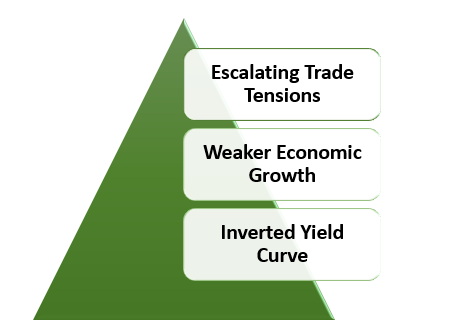The ongoing trade dispute between the United States and China has shaken the world economy, increasing concerns of weaker global growth in the coming years.
The Organisation for Economic Cooperation and Development (OECD), in its ?Latest Economic Outlook?, has projected that the global economic growth will slow down from 3.6 per cent last year to 2.9 per cent this year, which is the weakest annual growth rate observed since the 2008-2009 financial crisis.
OECD has also lowered the forecast for 2020 from 3.4 per cent (previous projection) to 3 per cent.
OECD?s Latest Economic Outlook
OECD has given weaker growth prospects for most of the countries across the world amid escalating trade conflicts.
As per the latest outlook, both advanced and emerging economies are likely to observe weaker growth without any firm policy action from governments.
The economic organisation has reduced the growth forecast for Australia to 1.7 per cent in 2019 and 2 per cent in 2020.
OECD outlook covered all the G20 economies and included revisions to projections from the earlier Economic Outlook of May 2019 (see figure below).
It can be seen in the above figure that out of all G20 economies, only Canada, Japan and Turkey?s economic growth projections have been revised upwards from OECD?s previous economic outlook.
As per OECD, the trade conflict is the primary factor that has undermined growth, confidence and job creation across the world economy. The persistent trade tensions and weakness in manufacturing sectors are likely to impair employment growth, household income and spending across the world.
OECD?s weaker projections were also driven by the following reasons:
- Continuing uncertainty about the nature and timing of the withdrawal of the UK from the European Union, raising concerns of no-deal Brexit which could lead to sectoral disruptions in Europe and push the UK into recession in 2020.
- Overall slowdown in the Chinese economy.
- Considerable financial market vulnerabilities due to trade tensions between slowing growth.
- High Debt and deteriorating credit quality.
The outlook suggested the central banks in advanced economies to remain accommodative but highlighted that effectiveness of the monetary policy could be enhanced if supplemented by stronger structural and fiscal policy support.
As per OECD, greater structural reforms and the larger role of fiscal policy are required in all economies to enhance medium-term living standards and opportunities, and assist in offsetting the effect of negative supply shocks from increasing restrictions on trade and cross-border investment.
Is the US Economy Heading Towards Recession?
A recently released ?Bank of America Merrill Lynch survey? mentioned that the global recession risks over the next 12 months are at its highest since August 2009.
The market analysts are also predicting a recession in the US economy by 2020 presidential election amidst the current economic scenario. As per the analysts, the following factors depict the possibility of probable US recession:
Escalating Trade Tensions
The intensifying trade issues between the two largest economies of the world is one of the major reasons that can lead to the recession in the US.
The trade tensions began last year with the US President?s move to impose tariffs on imports of steel, aluminium and other metals from China. Since then, the US President, Donald Trump?s administration has continued to impose further tariffs on Chinese imports, blaming China for its unfair trade practices.
China, in turn, has also been imposing retaliatory tariffs on the import of US goods, further aggravating the conflict.
The series of tit-for-tat tariffs sparked a trade war between the two largest economies of the world, raising concerns of a recession in the US.
The aggravating tension induced the US Federal Reserve recently to lower the target range of its key interest rates by 25 basis points to 1.75 per cent - 2 per cent. Following a 25 basis points cut in July 2019, the Fed reduced its benchmark interest rate for the second time in September to sustain the US expansion.
As per Fed Chair Jerome Powell, the US central banks would ease monetary policy further if the US economy weakens.
Weaker Economic Growth
As per the estimates provided by the Bureau of Economic Analysis (BEA) of the US Commerce Department, the US economy grew at a slower pace of 2 per cent in the second quarter of 2019, after observing an economic growth of 3.1 per cent during the first quarter of 2019.
The growth rate in the 2nd quarter was 0.1 percentage point less than the advance estimates provided by the department in July 2019 and was the weakest growth observed by the country since the start of 2017.
The projections for the US economic growth have also been revised downwards to 2.4 per cent in 2019 and 2 per cent in 2020 under OECD?s Latest Economic Outlook.
The US manufacturing sector also contracted for the first time in August this year, with the fall in US manufacturing PMI to a level of 49.9 from 50.4 in July.
This was the lowest such PMI experienced by the country since September 2009, signalling a sharpest downturn in orderbook in ten years. The fall in new export sales and the deteriorating global economic conditions led to a shrinkage in the US manufacturing sector.
Inverted Yield Curve
It has been seen that the yield curve has inverted before every recession in the United States since 1975. The yield curve gets inverted when the shorter-maturity bonds usually pay larger interest than the longer ones.
The market analysts believe that the yield curve is likely to get inverted in the US economy, with the US 2-year treasury bond yield surpassing US 10-year bond yield in the near term.
As at 14:24 PM AEST on 20th September 2019, the US 2-year treasury bond yield is at 1.735% while the US 10-year treasury bond yield is at 1.77%. One can deduce that the difference between the short-term and long-term bond yields is very less in the US, creating a possibility of inversion and recession.
Although the US economy is showing several warning signs of a downturn in the near future, the US Federal Reserve is taking active steps to prevent a recession. Fed has signalled for further rate cuts in the economy to provide insurance against ongoing risks.
Disclaimer
This website is a service of Kalkine Media Pty. Ltd. A.C.N. 629 651 672. The website has been prepared for informational purposes only and is not intended to be used as a complete source of information on any particular company. Kalkine Media does not in any way endorse or recommend individuals, products or services that may be discussed on this site. Our publications are NOT a solicitation or recommendation to buy, sell or hold. We are neither licensed nor qualified to provide investment advice.?






